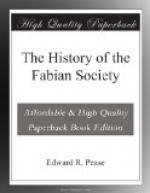Six months after the Labour Representation Committee was formed the Society adopted a project drafted by Mr. S.G. Hobson for a Labour Members’ Guarantee Fund, and circulated it amongst the Unions affiliated to the Committee. The proposal was submitted by its author on behalf of the Society to the Labour Representation Conference of 1901, but an amendment both approving of the scheme and declaring that the time was not ripe for it was carried. A year later however the Conference unanimously agreed to establish its Parliamentary Fund by which salaries for their M.P.’s were provided until Parliament itself undertook the business.
For several years after this the Fabian Society did not greatly concern itself with the Labour Party. I attended the Annual Conferences and took a regular part in the work of the Executive Committee, but my colleagues of the Fabian Society as a whole showed little interest in the new body. In a sense, it was not in our line. Its object was to promote Labour Representation in Parliament, and the Fabian Society had never run, and had never intended to run, candidates for Parliament or for any local authority. We had made appeals for election funds on a good many occasions and had succeeded once or twice in collecting substantial sums, but this was a very different matter from accepting responsibility for a candidate and his election expenses. Therefore, for a good while, we remained in a position of benevolent passivity.
The Labour Representation Committee was founded as a Group, not as a Party, and one of the two members elected under its auspices at the General Election of 1900 ran as a Liberal. In 1903 it transformed itself into a Party, and then began the somewhat strange anomaly that the Fabian Society as a whole was affiliated to the Labour Party, whilst some of its members were Liberal Members of Parliament. It is true that the Trade Unions affiliated to the party were in the same position: their members also were sometimes official Liberals and even Liberal M.P.’s. The Labour Party itself never complained of the anomaly in the position of the Society or questioned its collective loyalty. And the Liberals in our Society never took any action hostile to the Labour Party, or indeed, so far as I know, supported any of the proposals occasionally made that we should disaffiliate from it. These proposals always came from “Fabian reformers,” the younger men who wanted to create a revolution in the Society. And so little was their policy matured that in several cases the same member first tried to get the Society to expel all members who worked with any party other than the Labour Party, and a short time later moved that the Society should leave the Labour Party altogether. Or perhaps it was the other way round. Logical consistency is usually incompatible with political success: compromise runs smooth, whilst principle jams. But the lesser sort of critic, on the look out for a grievance, can always apply a principle to a compromise,




